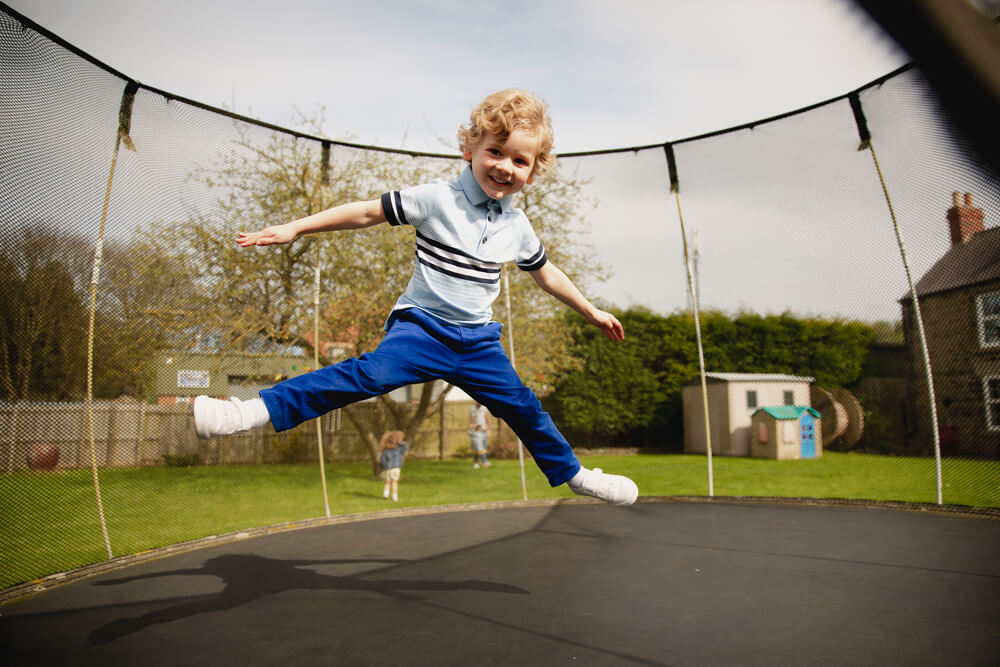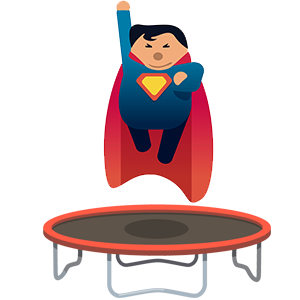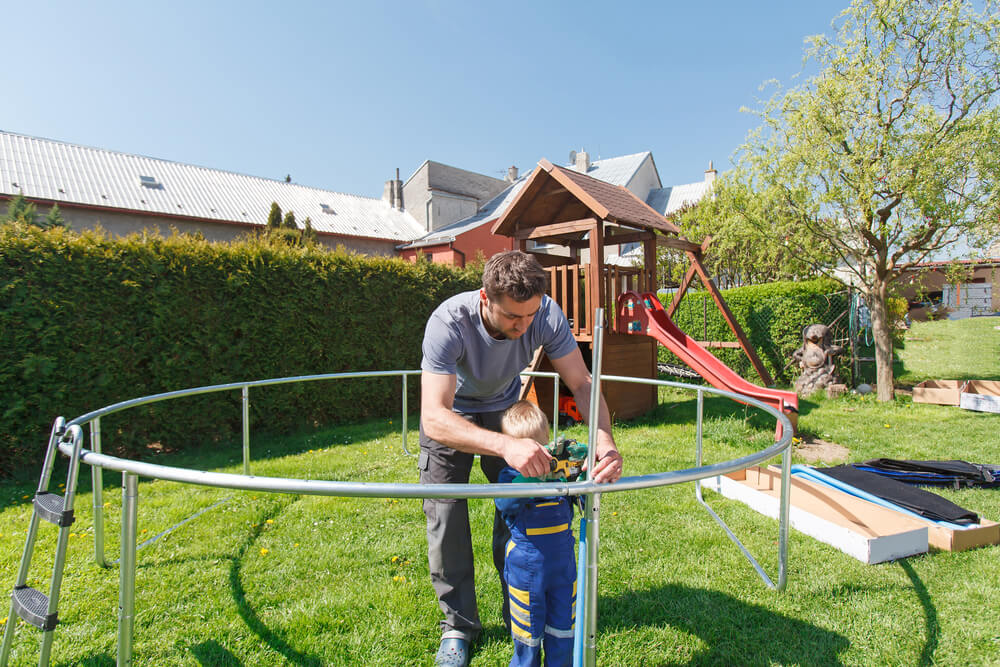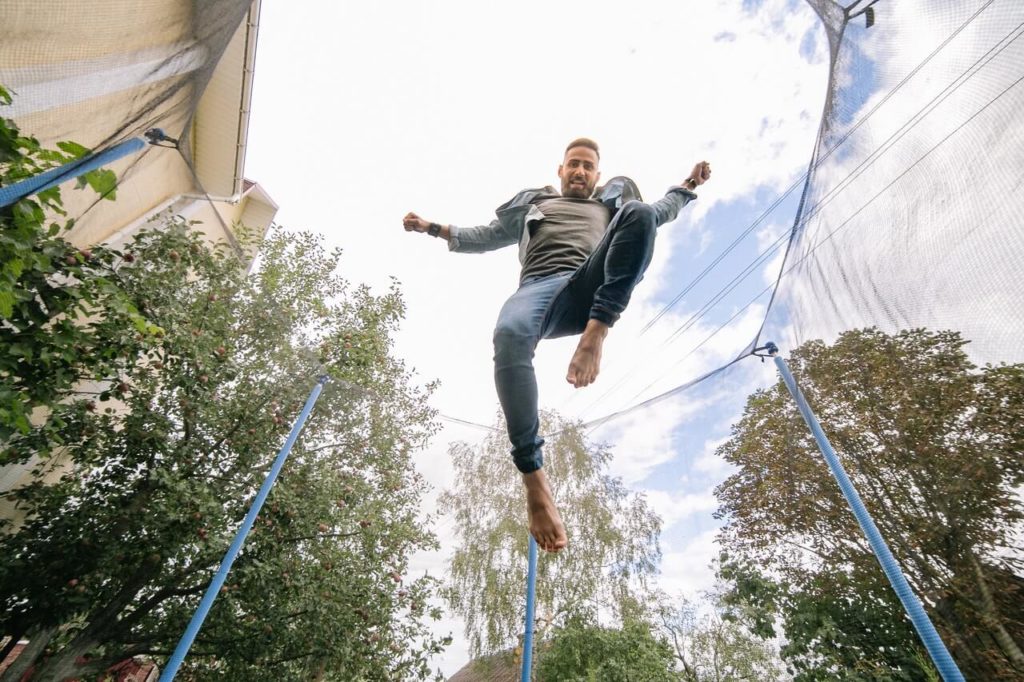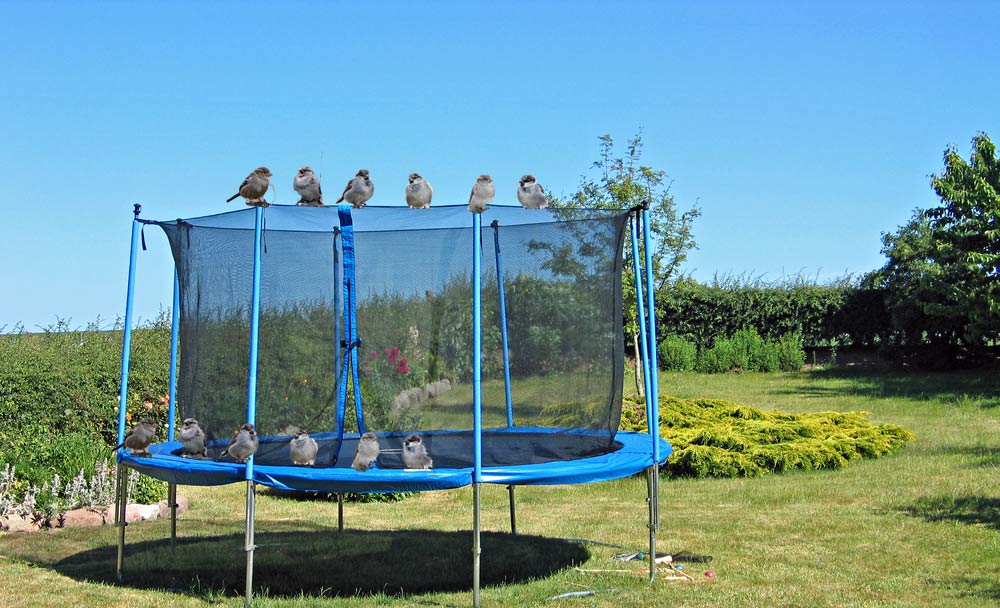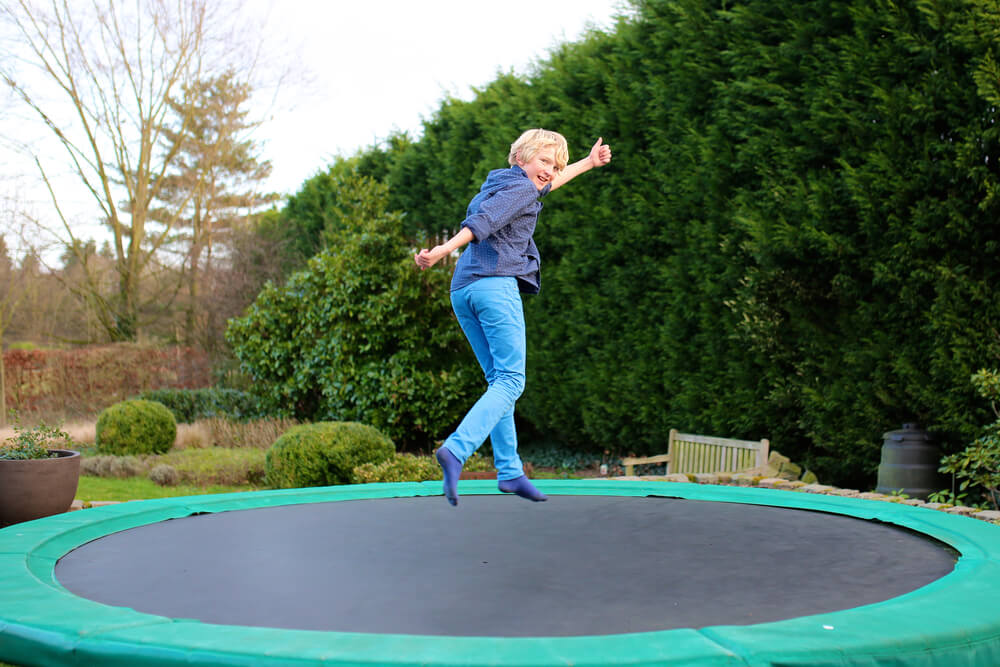Trampolines can be the best play gift you’ll ever get your child. Jumping on top of a trampoline can be a fun way to keep fit for children and adults alike.
Trampolines can help improve cardiovascular health, balance and coordination, and tone muscles for people of all ages.
A high-quality trampoline can also attract several children to play together, helping develop your kids’ social skills.
Another thing.
Bouncing on a strong backyard trampoline can provide tons of fun family time for children and adults to bond.
Still, home trampolines are within the safety of your watchful eyes, so you may be able to help protect your children from common trampoline accidents.
But there is something else.
When gymnast George Nissen patented the “tumbling device” in 1945, he recommended the trampoline for training acrobats, gymnasts, and military aviators.
So, what are the odds of getting hurt on a trampoline? Are trampolines dangerous?
Is the trampoline the most dangerous toy in America?
This post will help you see the potential dangers of trampolines and offer trampoline safety tips to protect your loved ones each time.
Are Trampolines Dangerous?
One thing is sure: you do not want to overdo anything on a trampoline.
But how safe is a trampoline?
Trampoline jumping may be relatively safe compared to riding a big bike, using playground equipment, or swimming in a large pool.
Still, the American Academy of Paediatrics (AAP) recommends taking as much precaution when using a trampoline as you would when swimming with your child in a pool.
So, you’ll still want to follow trampoline safety guidelines whenever you use one. And why not when a rise in trampoline-related injuries has correlated with an increase in trampoline sales over the years.
Trampoline Injury Statistics
- The rate of trampoline-related hospitalizations was approximately 3% between 2005 and 2009.
- During that time, most injuries (163 per 100,000) occurred in children between 5 and 14 years.
- The AAP published a report in 2016 showing trampoline park injuries increased significantly while home trampoline injuries did not increase between 2010 and 2014.
- Up to three out of four injuries happen while several children are jumping on a trampoline at the same time.
- According to the American Academy of Orthopedic Surgeons, arm injuries are the most common (60%), followed by leg injures (36%).
Still with us?
Then here are more answers to some of the trampoline safety questions you may have.
Are trampolines dangerous for toddlers?
Absolutely. Small children are 14X more likely to get hurt than older children.
While older children may experience ankle sprains or knee twists, smaller children are more likely to suffer bone injuries. The younger a child is, the more likely their bones are still too soft to withstand twists and turns.
So, only buy trampolines for children six years or older. If you have younger kids, do not let them use a trampoline.
Can jumping on a trampoline hurt your brain?
Tumbling awkwardly on a recreation trampoline can lead to head and neck injuries, the most concerning types of injuries anyone can have on a trampoline.
Falling off a trampoline, colliding with another jumper, and landing awkwardly on your head, neck, or shoulders, can lead to traumatic injuries that can affect the brain.
Are trampolines bad for the spine?
Rebonding translates to twisting, flipping, and other stunts on a trampoline.
If you or your child attempts acrobatic stunts that they aren’t trained to do safely, they may suffer neck, cervical spine, and other acute spinal cord injuries.
While severe spine injuries are rare, an occurrence could lead to paralysis.
Are trampolines dangerous when wet?
Certainly. A wet trampoline can lead to slips, imbalance, and awkward landings, leading to bouncing off the edge or falling on the hard edges.
Ensure every jumper removes their shoes and socks to reduce the likelihood of slippage-related injuries.
Is it true that trampolines are dangerous even with nets?
If a trampoline has unprotected net poles, it may pose an increased risk to jumpers.
Today’s best trampolines come with safety nets that include padding accessories for the poles and entire metal frame.
Rectangular vs. Rounded Trampolines: Which Shape is Safer?
You’ve probably heard the rumor, but is it true?
Are rectangular trampolines safer than round trampolines?
Well, there aren’t adequate reports to show that rectangular-shaped trampolines offer more safety than circular trampolines.
However, note the following:
- Rectangular trampolines gravitate jumpers towards the middle than rounded units do. So they may help jumpers to keep off the unit’s hard edges or falling off.
- They also do not offer the high bounce typical with rounded trampolines. That may help jumpers better control their jumps and rebounds, leading to fewer sprains, for example.
- Compare to circular models, rectangular-shaped trampolines tend to offer rebounds consistent in height and power, so jumpers may more easily predict where they’ll land next.
- While rounded units are ideal for skilled users who can handle high bounces, rectangular ones tend to accommodate less experienced jumpers, such as most children.
- Rectangular varieties also tend to offer more space to rebound on and accommodate more weight than rounded types.
Rectangular-shaped trampolines and their replacement parts also tend to cost more than circular trampolines for those reasons.
Does a Trampoline’s Size Affect Its Safety Level?
A trampoline’s size can also affect its safety level like its shape does.
For example, are small trampolines dangerous?
The less space a trampoline offers, the more likely a jumper is to fall off it. That is especially true in the case where bigger children and adults use a small unit.
Recreational trampoline sizes range between 8 to 16 feet. A 12-foot trampoline is the standard size you’ll want to get to improve its safety. You can get a larger unit if adults will be using it as well.
Check out our How Much Weight Can a Trampoline Hold and How to Measure a Trampoline guides to find the best size trampoline for your child according to factors such as age, weight, and overall health.
How to Make Your Trampoline Safer: 30 Trampoline Safety Tips
Follow these safety tips, and you are likely to keep your loved ones safe from trampoline accidents at home or away.
- Confirm with your child’s pediatrician if it’s safe for you or your child to rebound
See if the doctor agrees that your child’s bones and overall health can allow him or her to bounce on a trampoline.
- Establish rules of engagement in advance
Teach both adults and children about the risks involved. Then demonstrate how to use one safely at a trampoline park. Finally, test if they’ve understood the safety guidelines before buying one.
- Buy a high-quality trampoline
The safest trampolines use high-quality mats, springs, frames, stands, nets, net poles, and other accessories. Cheap trampolines may cut corners and use weak parts, exposing your loved ones to risk.
- Carefully read the manual
Ensure every user understands the right things to do on the specific unit you buy based on its manufacturer’s recommendations, such as bouncing time, weight, and jump height.
- Get professionals to install the trampoline for you
Installing a trampoline DIY may expose your loved ones to dangers if some parts do not come together right, for example.
- Keep children below six years off the trampoline mat
The AAOS reported that the younger children are, the more likely they are to suffer a severe trampoline injury such as concussions, bone fractures, and paralysis.
Early-life bone damage can also lead to stunted growth.
- Allow only one jumper at a time
Jumpers colliding into each other is a common trampoline accident and tends to lead to head and neck injuries.
- Don’t allow crazy stunts on or off the bouncing mat
Don’t allow somersaults, cartwheels, and gymnastics-level flips on the unit.
- Keep rebounding sessions short
Remember, fatigue and sleepiness increase the risk of suffering from an injury.
- Use proper protective equipment for high-risk maneuvers
For gymnasts, divers, and competitive sports training sessions, ensure jumpers are wearing the right protective gear for the trampoline specifications.
- Gravitate towards the center
Keep jumps at the center to avoid falling off the edges or hitting the metallic frame and springs.
- How can you tell that a trampoline is unsafe?
Some giveaway signs of an unsafe trampoline include:
- Creaking sounds
- Rusting parts
- Loose trampoline mat
- Bent frame
- Inflexible or loose springs
- Torn safety net
- Exposed net poles
- A trampoline mat that has tears in it
Replace worn out parts with new trampoline replacement parts.
- Use the right trampoline size for its users’ weight
Most outdoor trampolines for children hold up to 250 pounds. Full-size trampolines for adults can accommodate up to 350 pounds at a time.
- Use an age-appropriate trampoline
For children above seven years, use a 12-foot trampoline. Pick a full-size, 14- to 16-foot trampoline for adults.
- Keep snacks away from the trampoline
Food and beverages can make the mat slippery, increasing the risk of sustaining an injury.
- Empty all pockets before jumping
That should help keep all manner of debris off the surface of the bouncing mat.
- Supervise jumpers
Always have mindful spotters for jumpers of all ages.
- Get a netted trampoline
Enclose the edges with high trampoline safety nets. The taller the users and bounce height achieved, the higher the enclosure should reach.
- Grab those paddings, too
Use high-quality shock-absorbing padding on all hard surfaces such as net poles, frames, and springs.
- Keep the gate zipped shut
Ensure users zip the net’s door before jumping to avoid falling through the gaping hole.
- Keep it level
Have the unit installed on a flat surface to improve balance.
- Place it away from accident-prone areas
Avoid placing it on concrete, asphalt, or even hardwood flooring. Use sawdust, grass, hay, or padding around and under the unit instead.
Also, keep the rebound haven at least eight feet from fences, walls, trees, pools, and streets to improve safety.
- Teach users how to get off the trampoline safely
Discourage bouncing off the trampoline. Show users how to stop jumping, walk to the edge, sit down on it, and ease off the trampoline.
Alternatively, use a ladder or stable chair to help them off the edge.
- Ensure they use the right trampoline safety clothing
Use athletics clothing using a trampoline.
- Restrict access to the trampoline
Remove any ladders or chairs from around the unit when you are away.
- Check if your homeowner’s insurance policy includes a trampoline exclusion
See if your insurer covers trampoline-related injuries if you should experience one and need keen medical attention.
- How to tell if your child has a trampoline-related injury
Here are some signs you need to see a doctor after a trampoline accident, some of which are medical emergencies.
- Severe swelling on and around the injury
- Headaches that get worse with time
- Joint pain that won’t go away
- Twisted limb joints
- An injury that exposes the bone
- Confusion and dizziness
- Loss of consciousness (this is a medical emergency)
Those are some common symptoms of trampoline injuries.
- Adhere to these trampoline safety rules consistently
It is easy to relax these trampoline safety guidelines after using the unit safely for some time.
Keep the rules in high-gear all the time, even when you get additional trampoline safety features installed.
- Buy the top-rated trampolines for safety
Use positive referrals and reviews to gauge other users’ safety experience with the kind of trampoline you want to buy.
See if the manufacturer offers guarantees, friendly return policies, and decent warranty terms.
The more generous those offers are, the more likely that the trampoline purchase will remain a high-quality and safe unit for a long time.
Are there specific trampoline brands that are top-rated for safety?
Trampolines are not made equal.
Some brands are well-regarded over others for offering high safety standards, confidence-inducing safety records, and durable parts.
Discover what makes a trampoline safe in this next section.
What Are the Top-rated Trampolines for Safety?
In this quick safest trampoline buying guide, you’ll discover the models you can depend on to keep your loved ones enjoying the bounce without worrying about potential concussions and knee fractures.
Image: Unique, 13-foot jumbo Springfree Trampoline with Soft-Edge technology
Springfree quickly takes the top podium finish for World’s Safest Trampoline.
The most significant difference about a Springfree model is its unique design, which maximizes safety without cutting back on fun. No hard areas. No way to fall off the flexible and formidable enclosure.
Why choose Springfree models:
- Instead of springs, all 6- to 13-foot models use flexible rods placed several inches under jumping mat edges, so there are no hard surfaces to worry about.
- That design also increases rebounding surface area, which can help protect users against falling off the models.
- Safety netting covers the entire trampoline mat, attaching directly to the mat, so limbs won’t stick in-between springs as it typically happens on traditional designs.
- High and robust netting keeps excited jumpers safely inside the trampoline.
- The net comes with a steel band at the top where you can attach accessories such as a basketball hoop.
- Flexible net poles curve outwards, not inwards, to help keep the hard metal surfaces out of the way of a jumper in mid-air.
- Springfree’s 10-year warranty covers everything on the trampoline. Everything.
- You’ll have nine sizes and three shapes to choose from, too.
- The brand assembles the models in their factories before shipping them to minimize risks that mediocre DIY installations can pose.
- Springfree models are hard to move once installed, meaning they remain reliably stable even under maximum load and varying weather.
- Speaking of, their models are incredibly weather-resistant, which translates to longevity, value for money, and fewer maintenance costs to retain their high safety standard.
- They’ve received multiple awards for trampoline safety, which inspires buying confidence.
What you might not like:
- Springfree trampolines may seem expensive if you are out to find a budget trampoline.
- BouncePro Trampolines
Image: 14-foot BouncePro trampoline with safety enclosure
The company offers both small and full-size backyard trampolines for adults and children alike. Some tiny models do not provide safety nets.
Like Springfree models, BouncePro trampolines come with several excellent safety features. But unlike Springfree, its models tend to be more affordable.
Why choose BouncePro models:
- If you prefer the classic, rounded trampoline shape, BouncePro will have you covered.
- The high safety net is useful at keeping jumpers on the mat, considering the rounded shapes.
- The netted enclosure stitches directly with the mat to keep ankles, arms, and toes away from the springs.
- While the springs are outside the enclosure, they are still covered in generous padding to keep hard knocks out of sight and mind.
- Net poles curve outwards so jumpers won’t hit them in case of an awkward rebound.
- Stable steel stands mean you can depend on it to hold you up while flexing enough to avoid bends.
- Zippers are sturdy enough to protect a jumper from falling through.
- They use UV-resistant materials so you can keep it outside in the sun without worrying about deterioration that could reduce its safety level.
- Rust-resistant steel supports the frame’s integrity dependably, so you won’t have to worry about it over time.
- Great value for money for all the safety features you’ll get.
- It offers decent warranties on the steel frames and mat.
What you might not like:
- While there is a variety of shapes to choose from, there’s just one shape–rounded.
- Assembling the trampoline takes less than an hour, but it is not for everyone.
- Short warranty on overall models
- Skywalker Trampolines
Image: Different Skywalker trampoline shapes, sizes, and prices
These are perhaps America’s most popular trampoline brands. One reason for that is Skywalker models offer a good mix of safety, affordability, and longevity.
Finding Skywalker replacement parts and accessories to repair or replace unsafe components won’t be a problem due to their popularity, either.
Why choose Skywalker models:
- Trampoline enclosure netting comes sewn directly into the jumping mat. The no-gap design keeps loved ones from hitting hard edges or getting stuck in-between springs.
- Skywalker trampolines offer good bounce overall.
- All models meet ASTM safety standards for keeping your loved ones out of harm’s way.
- Models come in different shapes and sizes. That includes a 17-foot Olympic-size rectangular trampoline with a safety enclosure, great for acrobatics, diving, and gymnastics training at home.
- All models come with padded spring covers to reduce impact injuries along the edges.
- Most models ship with enclosure poles that curve outwards, thinning the chances of hitting the metallic rods.
- Skywalker models have high weight tolerance, so they likely won’t collapse or bend under an 8-year old as well as an adult’s weight (provided it’s one of their full-size models)
What you might not like:
- Their nets may be thinner than you’d expect, especially if you are coming from another brand.
- That means you may have to replace them more frequently than in other brand’s safety enclosures.
Image: JumpKing 15’ by 17’ oval Trampoline with enclosure, halfway zipper seam, and two basketball hoops
Like Skywalker models, JumpKing units come in a variety of shapes and sizes for all ages. You can also find an ideal model for your specific budget.
Instead of netted enclosures, JumpKing’s tiny models come with a firm, stable, and padded handlebars to protect young children.
Why choose JumpKing models:
- Large models come with netted enclosures that isolate the hard edge and springs from the jumping surface.
- All models ship with foam spring pads to soften any awkward landings along the edges.
- On top of their good-quality dual-zippers, the brand also uses a clip closure mechanism to offer an extra layer of protection from falling through an entry gap should the zipper ever fail.
- Yet the zippers’ seams rise just halfway up the enclosures to prevent jumpers from falling through seam gaps mid-air when they are least likely to control where they’ll land.
- Hexagonal steel stands increase stability and help prevent bends even after repeat bounces.
- Like other brands on this guide, the company follows ASTM standards, which means they test their models up to 4X the recommended user weight.
- To match their reputation for offering high bounce, JumpKing also offers roomy trampolines that keep users from falling off the units (especially their square and rectangular models).
- A rust-resistant frame protects the models’ weight-holding, flexibility, and bounce-absorbing integrity outdoors. It comes with a 3-year warranty.
What you might not like:
- Their 1-year overall product warranty is shorter than many competitors here.
- Propel Trampolines
Image: 14-foot Propel Trampoline with enclosure and padded edges
Propel models make good indoor and outdoor trampolines. Like others on here, they come in several different shapes, such as rounded, oval, square, and rectangular, as well as padded poles.
You can also buy the right size for your needs, from a small 7-foot unit for kids to a full-size 15-foot model for adults or older children—all without costing you a small fortune.
Why choose Propel Models:
- Good bounce height for dunking, diving, skiing, or skating training.
- Trampoline enclosure nets out the springs and hard frame area.
- All models come with padded edges to soften edge landings.
- Entry seams seal tight to protect users from falling through and off the trampolines.
- Up to six steel stands help hold the units’ integrity firmly in a hexagonal lineup.
- T-bracket frame welding prevents it from twisting in any weather.
- A high-strength bungee connects all enclosure poles for added strength against repeat bounces and windy conditions.
- Assembling the models is fairly simple.
What you might not like:
- The spring cover padding might feel quite thin.
- Enclosure poles bend inwards, which might increase the chance a loved one might come into contact with them mid-air.
Image: Zupapa 15-foot Safety outdoor trampoline with enclosure and extended net poles
Are Zupapa trampolines good?
They do offer several benefits that are similar to what the top trampoline brands in this list offer. The brand also stands out for including safe entry and exit ladders with all models.
Plus, you can choose an ideal size for your loved ones’ weight and age.
Why choose Zupapa Trampolines:
- All models offer high-strength enclosures with polyethylene safety nets. The tough netting can help stop awkward jumps and gravitate a jumper to the center of the unit.
- W-shaped stands make the units resistant to twisting and bending.
- UV-protection on the net helps preserve the models’ safe conditions both indoors and outdoors.
- All models offer enclosure poles that extend down to reinforce the legs, allowing the trampolines to hold up to 425 pounds without the risk of breaking.
- The frame warranty extends ten years.
- Double-layer safe pads cover the springs to cushion all manner of uncontrolled contacts.
What you might not like:
- Zupapa limits its models to the traditional, rounded shape.
- Some competitors offer similar safety features more affordably.
- AirZone Trampolines
Image: AirZone Jump 12-foot backyard trampoline with enclosure
AirZone models offer variety in terms of shape and size, including several rebounders. They also provide many of the competitors’ safety features.
That includes high-gauge galvanized frames to hold maximum weight without tumbling down, twisting, or bending under load or rough outdoor weather conditions.
Why choose AirZone models:
- Expect full-size models to come with polyethylene safety nets, which are both soft and tough for keeping jumpers within the surface area of the enclosed polypropylene trampoline mat.
- All models ship with UV-resistant mats and nets to maintain their safety features for longer.
- Foam pads cover all enclosure poles to soften mid-air contacts.
- Plus, all poles curve outwards, away from the path of a wayward bounce to minimize injury.
- Pick from an 8- to 15-foot size trampoline based on loved ones’ weight and age.
- W-shaped stands add stability.
- Reinforced bungees at the top help add strength and flexibility to the enclosures.
- Ideal for parents who want a quality, midrange trampoline.
What you might not like:
- You’ll be limited to buying a rounded model.
- AirZone models offer short warranties, which might not feel as assuring as its competitors.
- They do not make mini trampolines for kids if you are looking for one.
Trampoline Safety: Bottom Line
Using home trampolines can be a fun way to get active, enjoy family fun, and keep fit from the comfort of your backyard.
But experts warn that twisting, somersaulting, and doing cartwheels on backyard trampolines is one of the leading causes of trampoline injuries in the country.
Trampoline accidents can cause various injuries, ranging from mild swelling to ankle twists and bony breakages.
In severe cases, you or a loved one can suffer severe neck, spine, and brain injuries. Such injuries can be painful, costly to treat and take long durations to heal.
That’s why this trampoline safety guide offered 30 tips you can start putting to action even before you buy the best trampoline you have in mind.
Over to you.

